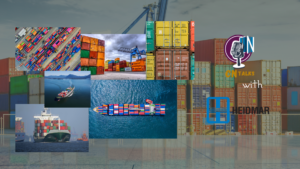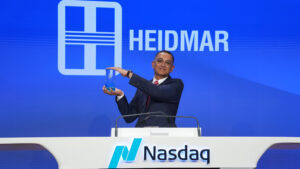Interview with Pankaj Khanna, CEO at Heidmar

![]()
In this exclusive interview, Container News Journalist Antonia Saratsopoulou speaks with Pankaj Khanna, CEO at Heidmar. Mr. Khanna discusses Heidmar’s strategic move into the feeder container market, highlighting favorable market conditions, growing regional demand, and the company’s focus on technical excellence and digital innovation. With decades of experience, he outlines how Heidmar plans to leverage its tanker expertise to bring value and efficiency to the container sector.
Could you introduce yourself and tell us a bit about Heidmar Inc., its background, main areas of operation, and how it has evolved in the global maritime industry?
I’m the CEO, and one of the main shareholders of Heidmar. Heidmar has been around for more than 40 years. The company started as a tanker pool operator back in Connecticut, and over the years has evolved. I acquired Heidmar in November 2020, did a full management buyout, and since then have been taking the company in a different direction.
To give a little bit of background on myself, I’ve been in maritime and offshore for almost 38 years. I started working on board ships as a cadet. I got my chief mayor’s license, and then I moved to the shore side. On the shore side, I’ve worked on everything, from tankers, bulk carriers, LNG, ultra-deepwater offshore, also worked on the services side, and recently in the container sector.
When I acquired the company, we were purely doing tankers. We were a pooling company, which we still are. Pooling is the core area of the company. It’s an expertise that we have developed over 40 years, and the name of Heidmar is synonymous with tanker pools. We were the first tanker pool that was started in the industry.
In the last five years, we basically evolved to a point where we have diversified into dry bulk on the commercial side. We also do technical management, and recently, the foray into the container market. To explain Heidmar’s strategy in a nutshell, basically, we have two lines of business.
We are a maritime service company,where we provide commercial, technical, and corporate management. And on the other side, we develop projects. So the entry into the container sector has to do with the other part, which is the project development.
On the maritime services side, basically for a financial investor, we can provide full services from identifying a sector to invest in, executing the acquisition, setting up the corporate management, commercial management, and technical management. So, effectively managing the entire investment for the investor.
Additionally, for a strategic investor, which is a ship owner, Heidmar is a boutique of services, where you can choose any or all of the services. We are also assisting owners to go from dry bulk into tankers, to go from small tankers into large tankers.
Heidmar has long been a leader in tanker and bulk shipping. What prompted the decision to enter the container shipping market now, and why begin with a feeder vessel?
When we were looking at projects, we looked across the tanker, bulker and container sectors. In the tanker sector, which is our backyard, right now asset values are quite high, and the charter periods, and the charter rates do not justify the asset value. So we looked at the container market.
On the dry bulk side, asset values have come off historically; they are still somewhat high, but there is no period market. So, it’s a very short-term market. At the most, you can get 12 months, and the rates are low, and don’t justify the asset value.
Now, at the container market, because of the COVID, the closure of the Red Sea, the tariffs, demand in terms of ton-mile has increased, there is more demand for ships. For all these different reasons, there are inefficiencies in the market.
As a result of that, the charter rates are still historically at very healthy levels, and the period is still available. You can easily get 2, 3, 5, 10 year charters depending on the size of the vessel.
Our focus on feeders is for a couple of reasons. Firstly, at the feeder sector, the profile of the fleet age is 15 years on average. The order book is very small, it is basically about 4% or 5%. And then the demand for feeders is rising because of the moving around of the production. Production in terms of manufacturing is being dispersed out of China into wider Southeast Asia, Latin America, South America, and Africa as well. So that would disperse the trade, so these pendulum trades that were prevalent for the last 20 years.
I think there is a move where you will see more north-south trades, more trades where feeders are required to feed the hubs, so that the big ships can then go. And then, of course, the tariffs in the U.S. also favor feeders so that larger vessels, which I think you cannot avoid Chinese-built vessels, especially as part of the new building fleet, especially if you want to decarbonize and make your fleet more efficient, you need new vessels where the consumption of the newer vessels is much lower than the older vessels.
And then if you look at the new building fleet, the Chinese-built fleet in containers is a huge proportion, it’s more than 50%. So, you cannot avoid Chinese-built vessels. Again, the feeders then play a role in assisting in keeping the port fees, within reason. So, we see increasing demand for feeders, we see a supply side of the equation, which is favorable, and we see healthy charter periods. Three to three years is achievable. And the rates justify the asset value. This is why feeders.

Can you walk us through the acquisition of the C/V A. Obelix? What made this ship the right fit for Heidmar’s debut in container shipping?
When we started the discussion, the USTR, talks were still underway, and there was this talk about Chinese-built vessels incurring very high fees in US ports.
So we were looking at non-Chinese-built vessels. This vessel is built in Germany, and is a very good ship, having been running with somebody we know for quite some time. So we found that this vessel was technically very good, was built in Germany, and was on a good charter with a very good feeder operator. It sort of ticked all the criteria.
We inspected the vessel as well. The vessel is in very good condition.
You’ve chosen to enter through the feeder segment. Is this a long-term strategic focus, or a stepping stone toward building a broader container fleet?
I think the broader container market from a tonnage provider standpoint is already quite well serviced. You have very large players in the segment. I used to work for Teekay, and I know Seaspan from way back in the 2000s, when they were still growing at a much earlier stage of their development than they are right now.
Being in Greece, I know Danaos, Costamare, among others. I think that the larger vessel market is well serviced by the tonnage providers. But when you drop down from 5,000 EU and below, maybe even 6,000 and below, that market is very fragmented in terms of ownership.
There is an opportunity to build out a tonnage provider in the feeder segment that could be of scale. So, I see that as an opportunity, whether Heidmar can fill those boots or not is a different matter. A lot of stars will have to align for us to get to that place.
My focus is on the smaller market. We want to stay in 6000 and smaller. We don’t intend to compete in the larger segment market. The capital required is very large. Once you go over that size segment, it becomes a different way. It’s not my market.
How does Heidmar’s commercial and technical expertise in the tanker sector translate into the container segment? What challenges or advantages come with that shift?
We are working with the major oil companies, the oil traders, and the national oil companies, who have very exacting standards. So from a technical standpoint, we work to a very high standard, have very high scrutiny on the tankers, and work with the SIRE inspections with the PSCs.
From a technical standpoint, we already work to a very high standard. So, this mindset of ours fits into the container market. We also understand arriving at the port on time. We have narrow laycan windows where we have to lift our oil. We have to arrive in time, to load the oil, and then we have to arrive in time to discharge the oil.
We also understand the liner company’s mindset in terms of getting to the port on time, having full uptime, and full utilization of the vessel. So I think operationally, our mindset is quite attuned to what a liner company, my client, my customer, will want.
With regards to the commercial aspect, we are very much accustomed to working in the spot market and the short-term TC market. So, again, not going into the bigger sectors where the time charters are for 5, 7, 10, 12 years, and staying in the smaller segment where the time charters are between 6 months to 3 years.
It again fits in with our commercial mindset in terms of how we work on the tanker side. So, I think that we will bring synergies over here, in terms of our understanding of the high requirements that our oil companies have of us.
That fits in exactly with what the liner companies want. The requirements are exacting; we understand that we have to perform to the highest standards in terms of utilization, on-time performance, and this is what we bring to the table.
Heidmar uses a capital-efficient co-investment strategy. How does this model apply to your container vessel investment, and what kind of returns are you targeting?
Shipping requires a lot of capital. This is our industry. CAPEX is high. Ιf you can tap different sources of capital, it assists in the growth strategy of the company. So Heidmar is already listed on Nasdaq. We did that in February. That gives us access to the U.S. capital markets, which isone of the most liquid markets in the world.
In addition to that, if we can tap into ultra-high net worth individuals, family offices, and other investors who are looking to invest in shipping, that provides avenue to them to invest in a good sector, which has good fundamentals.
At the same time, it gives us the ability to grow beyond our own sort of capital capacity that we have.We see a synergy in that where we can build out the company along with other investors. And as far as the return requirements are concerned, that really depends on the cycle as well.
When interest rates are at 0%, like they were 5, 6 years ago, versus where they are right now, return requirements change based on that.
When the interest rates are at 0%, even a return of 8, 9, or 7% was a very good return. When interest rates are four, five percent as a base rate, people expect maybe more in the sort of low teens or something like that.
So, from where we are right now in the cycle with feeders, the cash on cash returns are more than 20%. It’s a very easy sell at this point to show investors what the returns are and how attractive they are.
But that will depend on the cycle. If rates change, which they will over time, also interest rates will change, and that will also drive people’s return expectations.
Heidmar is known for its digital platform, eFleetWatch®. Will this technology play a role in your container operations as well?
 Heidmar has been at the forefront of digitalization. We did this almost 20 years ago. The founder’s son was an IT engineer, let’s say a wizard, and he not only set up the e-FleetWatch platform, but was also the founder of Q88, which has now been bought by Veson.
Heidmar has been at the forefront of digitalization. We did this almost 20 years ago. The founder’s son was an IT engineer, let’s say a wizard, and he not only set up the e-FleetWatch platform, but was also the founder of Q88, which has now been bought by Veson.
This is proprietary in-house software of Heidmar, where we effectively don’t use any Excel, any databases. All we work on is this ERP system. So, all our cargo ships, operations, chartering, invoicing, and claims, all of that is done on eFleet Watch.
Additionally, it is a portal to our partners who give their ships to us for management. We will use this portal and the platform for operating containers as well. And we have, of course, not applicable to the containers, but for example, on E-FleetWatch, we have seven terabytes of data going back 20 years.
We are now using AI to enhance what we do on the tanker and bulk carrier side, but we’ll be using those capabilities for the container market as well. Now, the container market is not spot-oriented, but it will help us with operational efficiency.
So, we monitor the vessel’s performance. We provide weather routing. We look at the fuel consumption of the vessel. We rate the vessel’s basis of the fuel consumption. People talk about decarbonization. Pooling is a methodology that encourages decarbonization because the better your fuel consumption at aspeed, the higher earnings you have in the pool.
Can you elaborate on how ESG principles are integrated into Heidmar’s operations, and how these efforts are aligned with long‑term business strategy and value creation?
Fuel conservation has been in the DNA of Heidmar. This is the entire principle of pools. So how do we rate a vessel in the pool? We take the speed & consumption of the ship and the characteristics of the vessel, and we rate the vessel basis that. But the speed & consumption aspect accounts for about 50-60% of the rating.
So if your fuel consumption is higher at that speed, you make less money, effectively. That encourages a ship or a ship owner to improve their performance. And in the past, performance has been improved where we have always done hull cleaning to ensure that the hulls are always smooth, and we have also encouraged owners to apply energy-saving devices.
So, from an ownership standpoint, now in containers, we went and bought a vessel which we think is the most competitive in the segment for its age. So this was a criterion for us when we looked at the ship. Going forward, we’re going to look at what we can do to improve the consumption because this almost has to become a thing that you do now for every vessel you buy, and how you operate, you have to think of how to improve the consumption.
Energy-saving devices are one, AMP, and using port power is another, battery packs are another, and if possible, we use various other devices in the engine room that improve consumption. Already, if you look at newer vessels, the fuel consumption has dropped 50% from what it was 10, 15 years ago. For the older vessels is what we need to focus on now, which is to use ESDs and shore power to try and decarbonize over there.
So, this is something that is top of mind for us. It’s not something that we think of when we buy a ship, let’s buy the most efficient well. That’s one thing you can do, but you can always improve the consumption, and especially with regards to better routing, optimum speed, and the tuning of the engine. These are easy things that you can do to improve the consumption of the ship.
As you build your footprint in the container segment, what can the market expect from Heidmar over the next year or two? And beyond containers, are there plans to enter additional shipping segments or expand into new maritime markets?
On the container segment, we are thinking more, can we create a company that can play a role in that market. Whether we’ll be successful or not, time will tell. But that is a strategy or a vision for the company to build our presence in the feeder container market.
As far as the other segments are concerned, our view on that is opportunistic. If a client comes and says, ‘’We want to buy a tanker, MR or a SuezMax, and we would like Heidmar to manage it, but we want Heidmar to have skin in the game’’, we will consider taking small equity slivers in those vessels. But we’re not looking to go out and acquire tankers or bulk carriers and build out the company in tankers and bulk carriers. It’s not the strategy of the company.
Pankaj Khanna added:
The container market is right now in a very interesting place because, you know, you have the whole upswing with COVID, and then people expected, with the order book, things would come down. But then the Red Sea closed. Now, with all this disruption with tariffs and the movement and dispersion of manufacturing, the container market is in a very interesting place right now, where it could again inflect, and the strength of the market could be a longer-term thing.
And so, it’s a very interesting place to be, where we are entering at a point where people are thinking that the market was going to come down, but on the other hand, that strength has been maintained and has gone up.
So, we are very excited about where the feeder container market and the small-size markets are, and we hope that we can play a role in consolidating there.
The post Interview with Pankaj Khanna, CEO at Heidmar appeared first on Container News.
Content Original Link:
" target="_blank">




































































